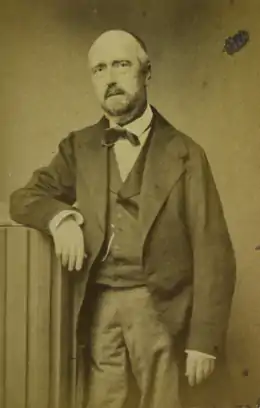Gustave Thuret
Gustave Adolphe Thuret, né le à Paris et mort le à Nice, est un diplomate et botaniste français.
Pour les articles homonymes, voir Thuret.
Biographie
Il venait d'une vieille famille huguenote, qui avait cherché quelque temps refuge aux Pays-Bas après la révocation de l'Édit de Nantes. Son père, Isaac Thuret (1771-1852), armateur, banquier et diplomate, consul général de Hollande, propriétaire de l'hôtel Baudard de Saint-James et des châteaux de Passy-sur-Seine, de Rentilly et de Lévis.
La mère de Thuret, Henrietta van der Paadevoort, avait été élevée en Angleterre si bien que l'anglais a été la première langue qu'il ait apprise, et il semble qu'il ait gardé de fortes sympathies pour la Grande-Bretagne tout au long de sa vie. Dans sa jeunesse, il a étudié le droit ; au cours de ses loisirs, il était un ardent musicien, et c'est au travers de son ami sur le plan musical, Alexandre de Villers, qu'il a reçu, vers 1837, sa première initiation en botanique. Débutant comme simple collectionneur, il ne tarda pas à être influencé par Joseph Decaisne (1809-1882), de qui il devint le disciple. C'est Decaisne qui fut le premier à l'encourager à entreprendre ces études algologiques qui allaient devenir sa principale œuvre.
On lui doit la première observation de fécondation sur le Fucus. Il fonda le jardin botanique de la villa Thuret à Antibes en 1857 où travailla Charles Naudin et qui est aujourd’hui un centre de l'INRA.
Texte anglais à traduire :
Thuret twice visited Istanbul in company with the French ambassador, Edouard Pontois, and was for a time attache to the French embassy to the Ottoman Empire. His diplomatic career, though of short duration, gave him a valuable opportunity of studying the Oriental flora. After travelling in Syria and Égypte in the autumn of 1841, he returned to France[1].
Giving up his intention of entering the civil service, he retired to his father's country house at Rentilly, and thereafter devoted himself to scientific research. He had already, in 1840, published his first scientific paper, Notes sur 1ère anthere de Chara et les animalcules qu'elle renferme, in which he first accurately described the organs of motion of the "animalcules" or spermatozoids of these plants. He continued his studies of the zoospores and male cells of Algae and other similar plants, and contributed to the understanding of such motile stages in vegetable life
Thuret spent a great part of his time, up to 1857, on the Atlantic coast of France, carrying out an intense observation of marine Algae in their natural habitat at all seasons. In conjunction with his friend Edouard Bornet, he became the recognized authority on this important group of plants, of which the two colleagues acquired an unrivalled knowledge. Their work, while remarkable for taxonomic accuracy, was more especially concentrated on the natural history, development and modes of reproduction of the plants investigated. They did much work in the area of sexual reproduction in seaweeds.
The researches on the fecundation of the Fucaceae were published by Thuret in 1853 and 1855; the complicated and difficult question of the sexual reproduction in Floridae was solved by the joint work of Thuret and Bornet (1867). Alongside the important discoveries in this area, the two scientists' researches helped elucidate every group of marine Algae. Thuret's style in expounding his results was hailed as singularly clear and concise; a man of thorough education, he was also noted for expressing his ideas with literary skill. Much of his best work remained unpublished during his life. A portion of the material accumulated by himself and his colleague was embodied in two magnificent works published after his death the Notes algologiques (1876–1880), and Études phycologiques (1878). These volumes, as well as earlier memoirs, are illustrated by accurate drawings by the artist Alfred Riocreux, whom Thuret employed.
In 1857 Thuret moved his research to Antibes (on the Mediterranean coast), where, on a once barren promontory, he established a botanical garden which became famous throughout the scientific world. Since his death the garden (now known as the Jardin botanique de la Villa Thuret) has been placed at the disposal of botanical workers as an institute for research[1].
Thuret died suddenly, while on a visit to Nice. He was a man of considerable wealth, which, together with his time and interest, he devoted to science.
 Buste de Gustave Thuret.
Buste de Gustave Thuret. Villa Thuret à Antibes.
Villa Thuret à Antibes. Pinus pinea - Villa Thuret à Antibes.
Pinus pinea - Villa Thuret à Antibes.
Références
(en) « Gustave Thuret », dans Encyclopædia Britannica, 1911 [Thuret ![]() (en) Lire en ligne sur Wikisource].
(en) Lire en ligne sur Wikisource].
Bibliographie
- Edouard Bornet, « Notice biographique sur M. Gustave-Adolphe Thuret », Mémoires de la Société Nationale des Sciences Naturelles de Cherbourg, vol. 20, , p. 69
Liens externes
- Ressources relatives à la recherche :
- Notices dans des dictionnaires ou encyclopédies généralistes :
- Notices d'autorité :
- Fichier d’autorité international virtuel
- International Standard Name Identifier
- Bibliothèque nationale de France (données)
- Système universitaire de documentation
- Bibliothèque du Congrès
- Gemeinsame Normdatei
- Bibliothèque royale des Pays-Bas
- Bibliothèque nationale d’Israël
- Bibliothèque universitaire de Pologne
- WorldCat
Thur. est l’abréviation botanique standard de Gustave Thuret.
Consulter la liste des abréviations d'auteur ou la liste des plantes assignées à cet auteur par l'IPNI
- Portail de l’histoire de la zoologie et de la botanique
- Portail de la phycologie
- Portail de la botanique
